Out-of-the-Box Book Marketing that Works
A soft launch for CAVE OF SECRETS over the weekend at the Michigan Highland Games.
When I wrote a novel set in Scotland, I pondered how to launch it in keeping with the culture that is embedded in the story. The St. Andrews Society of Detroit hosts an annual Michigan Highland Games celebrating Scottish culture and history, and the planners offered me a free vendor booth because my book promotes Scottish culture & identity.
So this past weekend, I presented CAVE OF SECRETS to the public for the first time, in a soft launch at the games. Boy was it fun! Read on to learn a bit about what the Highland Games are and why I’m so hot on Scottish culture.
P.S. Have you registered for my official book launches in just a few weeks? In-person and virtual options are available. Please join me for one or both!
And, listen to the CAVE OF SECRETS Spotify playlist here.
Scots & Jews share quite a lot: Both are rich in culture, tradition, food and story. Both have suffered expulsion and filled vibrant Diaspora communities with longing and ritual. Scots and Jews are generally proud of their heritage and have persisted despite great odds.
You can see I have great passion for my own heritage and a great love for Scottish culture. So you can imagine how passionate I am when I talk about this story.
And, no one will ever sell your book better than YOU.
Which is why in-person events are my preferred marketing method, and this past weekend I remembered why: the one-on-one conversations that happen over a book go deep, fast.
It was hard work managing a vendor booth in 90-degree heat for two days straight, but so worth it. The conversations and connections definitely sold the books.
Three teenage sisters approached my booth and shyly admitted that they write, too. A woman in a flowing floral dress bought my books and blushed as she said, “I’m also writing a book. I’ve never told anyone that.” So many fascinating, personal conversations as I stood behind the table and described my novels.
The connections are endless, and profound. I fully believe that’s why I sold so many books—the personal touch. Kindred spirits recognized one another. Because at the core, we are all frail beating hearts hoping for someone to see us.
I do all the marketing things—social media, newsletters, advertising and more—but in-person, face-to-face conversations with real people, where we share stories, that’s my sweet spot. It never gets old. And it always works—because it’s real.
Everyone wants an easy and quick way to sell their books, but guess what? There is no such thing. The more effort you put into it, the more books you sell. There are no short-cuts!
(In a future newsletter, I’ll share how I book speaking engagements!)
MICHIGAN HIGHLAND GAMES, 2024
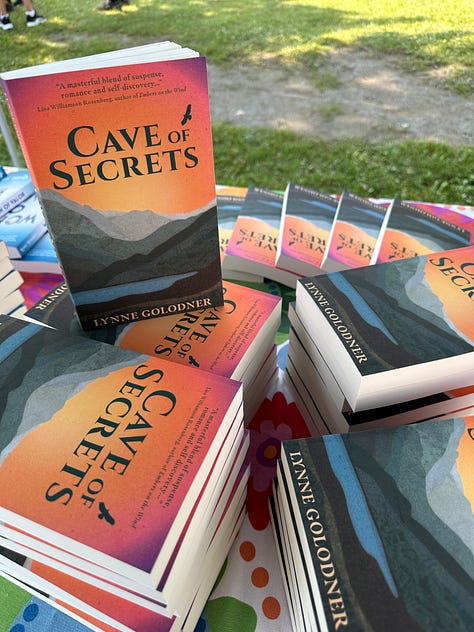
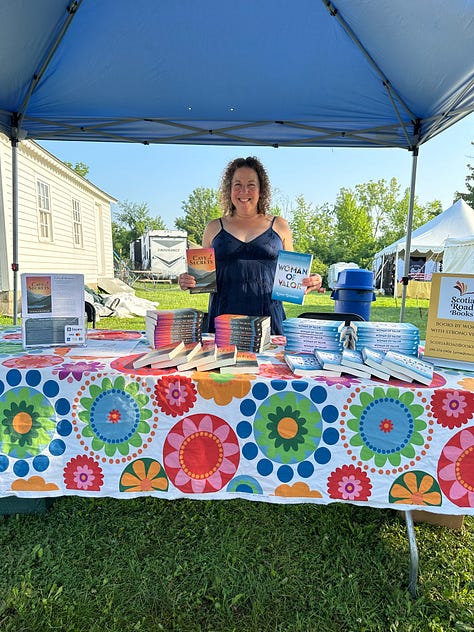

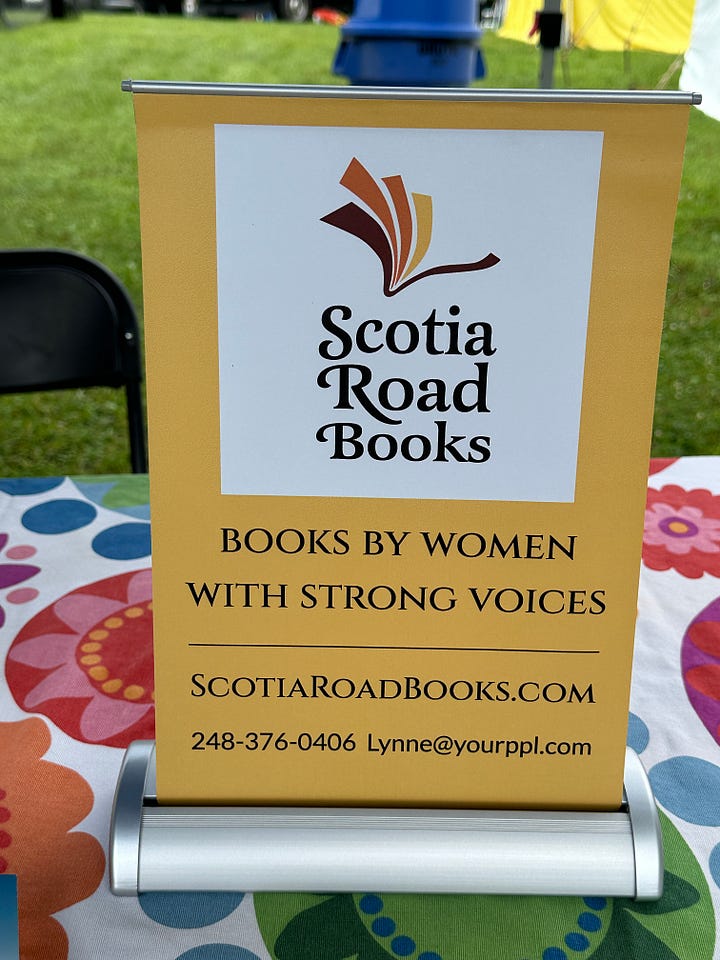
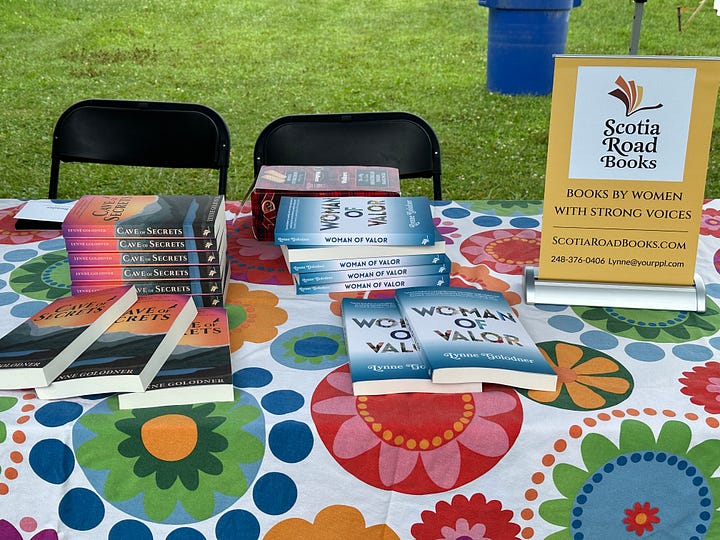
I almost didn’t want to go. Would anyone buy my books? It was forecast to be hot the whole time, and we’d be stuck under a tent for hours, and maybe no one would stop to buy a book.
Well, I’m so glad I went. Not only did I sell boxes upon boxes of my books, I met people, made friends and celebrated Scottish culture and marveled in the pride of being fierce in your identity, and strong.
Unlike my first Highland Games, two years ago in Scotland (read on below for more about that), I didn’t get to see any of the wonderful events because I was so swept up in speaking with readers and selling my books. However, I enjoyed the live bands that played not far from our booth and that Guinness that the beer vendor gave me for free Friday night tasted better than pretty much anything.
And I was reminded about how, at the core, people are just lovely. And kind.
The tent beside ours was the Infamous Welsh Cookie Co., and we befriended the couple who ran it. They had a steady line of eager customers the whole time, and we heard all about their show-to-show, on-the-road life from April through October. They gave us change when we needed it, and we did the same for them. Of course we ate their cookies. Of course they bought a book.
It was like that the whole time. People saying hello. People telling their stories, and asking for ours. The sense of camaraderie not only among vendors, but among all the many varied people who came to the event.
The first night, a woman walked by in the Jewish tartan (yes, there is one!) and a pewter Jewish Gaelic pin. Of course we got to talking and turns out, she’s a Jewish woman who grew up in the next suburb over from me, and she, too, writes novels. Hers are Jewish romance. I bought Scottish Judaica for myself, and am hoping to have a Jewish tartan outfit for the book launch thanks to another vendor who talked my ear off about how she, an Irish lass, grew up among Jewish kids, and now she peddles iconic apparel for both identities.
It’s a very small world indeed, and our stories are closer than we think.
THE HIGHLAND GAMES, July 2022, Inverness, Scotland
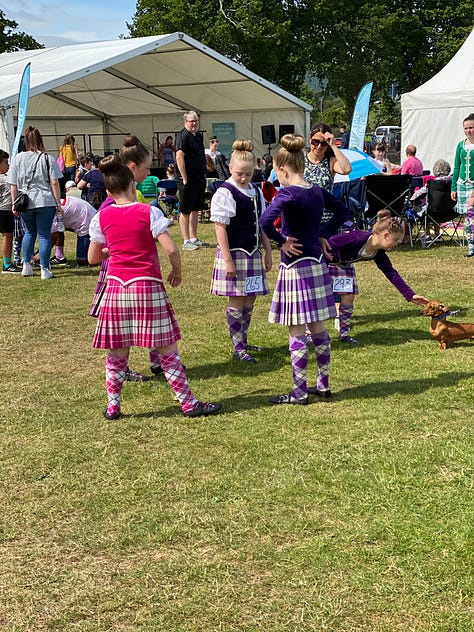
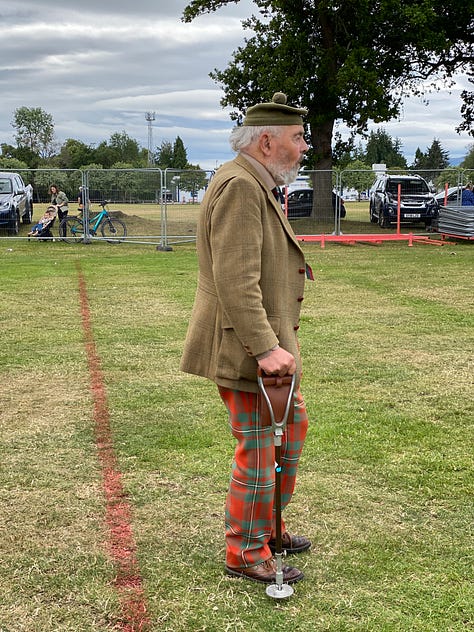

We parked at what I had come to call my spot, beside Inverness Cathedral, and joined a stream of people making their way along the river away from the city center toward the open fields of Bught Park where white tents and food trucks circled the green where the games would take place.
This was the 200th anniversary of the Highland Games in Inverness. I stood in a long line under a cool sun, inching toward the security tent, where a young chap peered into my bag and waved me through. I stepped onto the grass of the open field and tilted my face to the sky. The day was breezy, and bright. I’d worn jeans with a T-shirt and zip-up cashmere sweater, and I’d shed the sweater when the sun brightened then pull it back on as it hid in shadows.
Along the vendor tents, I gazed at art, jewelry, tartan purses. I spent a bit of time with a brand called FreKel, admiring handmade bags made from scraps of leather and kilts.
Winifred Sutherland, the older woman who owns the brand, with her teenage granddaughter facilitating transactions, told me how she’d launched the handbag company in 2016, after eighteen years running a pub. Based in Dunbeath, Caithness, a village in southeast Scotland, FreKel produces up-cycled bags made from old kilts and tweeds, and scraps from leather couches and jackets. It began in her kitchen with a single sewing machine, and now fills a workshop.
At the dance tent, little girls and teens, hair pulled into tight buns, pointed their toes and hopped from foot to foot in time to the music. They wore plaid skirts and knee socks, velvet vests with flouncy white sleeves or velvet long-sleeved tops. The dancers swelled in and out of the tent, where a stern-faced judge jotted notes as they bounced to the music. A man walked past with a cane, in orange and green plaid pants, a tan corduroy jacket and a tan tam o’shanter, a traditional Scottish cap with a poof on top. (I’ve bought a tam in the Jewish tartan for my upcoming book events!) A sweet man, with time etched into his face and swirls of white hair tufting beneath his tam, jolly as my long-gone grandfather, who always had a warm smile.
The girls danced three or four at a time in a straight line, hands on hips and feet turned out in second position. Some smiled. Some wore serious expressions. They bowed and the bagpipes started, then their motions alternating between hops, bounces, points, turns, hands lifted, faces serious. When they finished, they bowed to the judge, then skittered off stage single-file.
At a food truck, I ordered a grilled sandwiches with gooey cheese, thick cuts of meat and oozing splotches of preserves. I ate at a picnic table beside a couple in full Scottish regalia. The conversation started before I could swallow a bite. The woman was from France, but fell in love with a Scot, the land and the culture, and never left. The Highlands were home now, and the man at her side. They walked off arm in arm, full on life and love.
Under another tent, I perched on a hay bale to hear singers and musicians. Young women sang from their souls, fiddling and strumming.
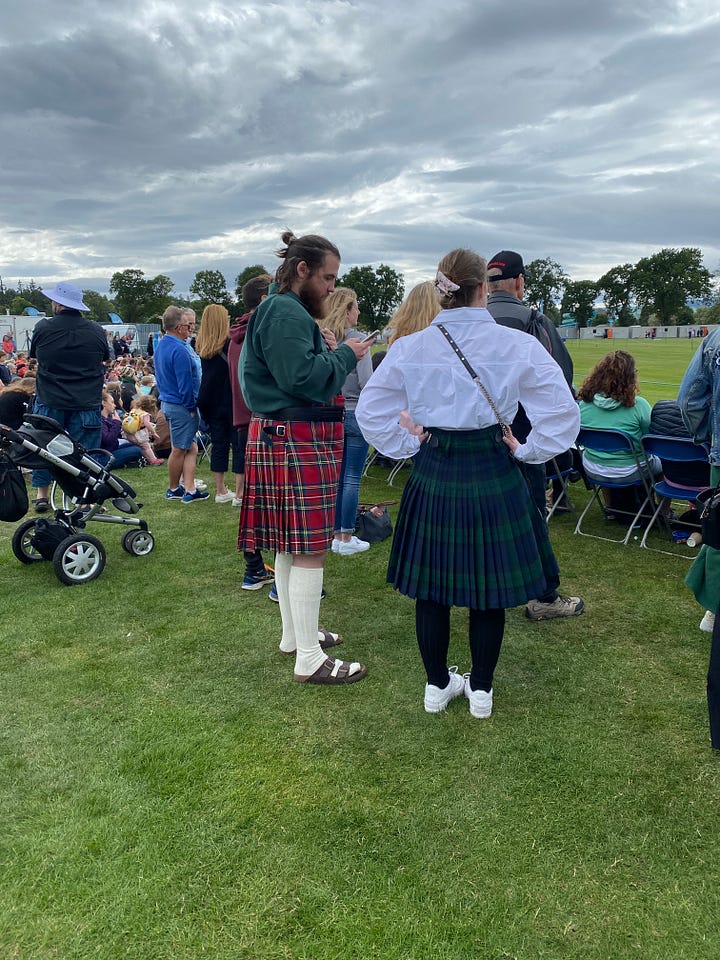
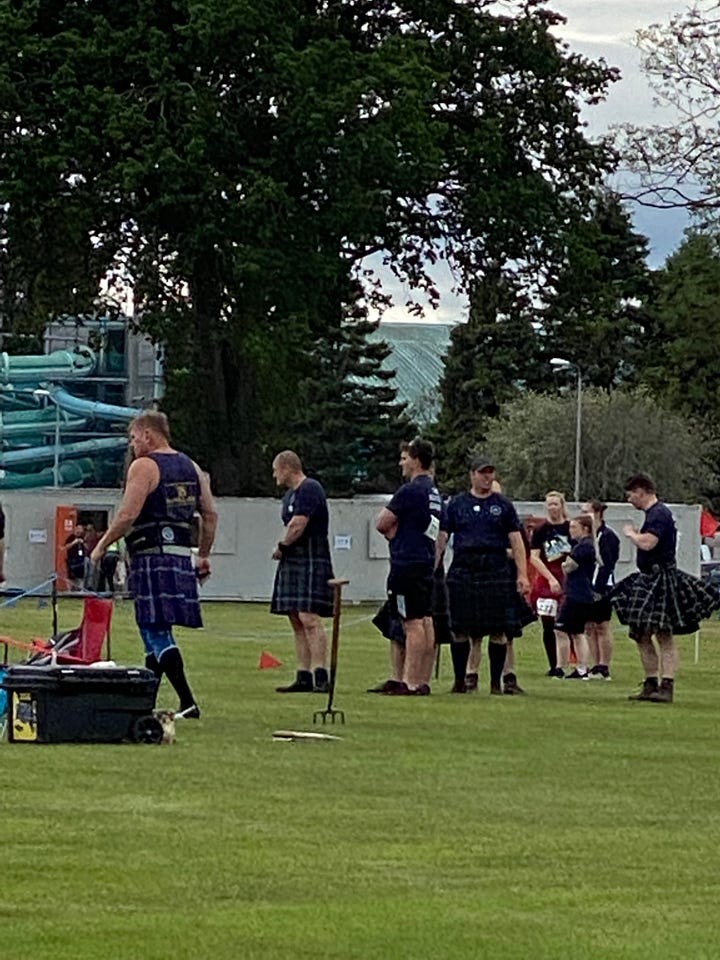

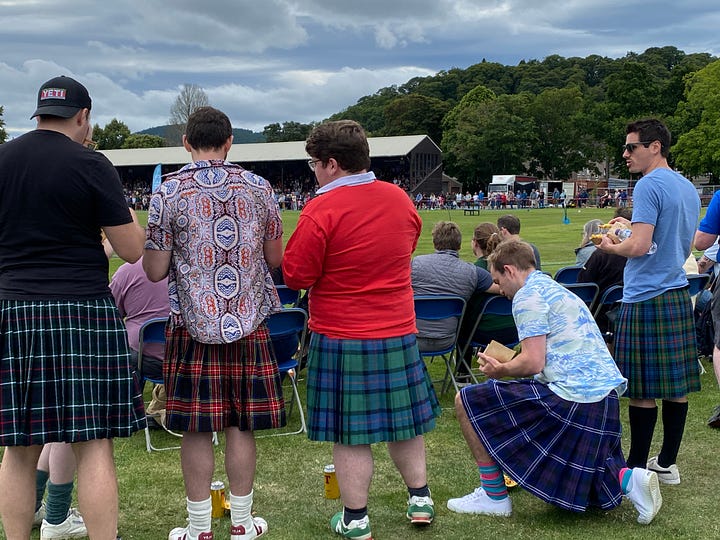
The games went on, big men in kilts hauling heavy objects to a starting point, whipping them around their heads or between their legs, and letting go, seeing who could throw the farthest. Kids and adults ran on the track. Women dipped and bounced and pointed in precise Highland dancing. Fife and drum bands in full regalia—kilts, knee socks, vests and short-sleeved shirts and tams—pounded drums, blew into bagpipes, moved in formation. The high-pitched rhythmic tone was hypnotic.
All these traditions, all this passion for preserving culture and place, for proving the steadfastness of ancestry in an era when everyone blends so easily.
I was there with a friend and late in the day, she pulled out a plaid flask filled with whisky. She handed me a little shot glass, poured us each a dram. I downed mine. The warmth seared my throat and traveled through my limbs. I felt electric.
“Another?” she tipped the flask toward my cup. “Medicinal,” I said, and we laughed.
The final event of Highland dancing featured couples in white skipping and hopping, grabbing hands, turning in circles, bowing under arms and coming back together.
A writer friend who lives in the Cairngorm Mountains of the Scottish Highlands insists that identity is conveyed through music, food, work and language there. It’s something to consider for anyone who has a strong tie to their ancestors, and an identity that defines so much of who they are.
I loved detailing Scottish and Jewish cultures in CAVE OF SECRETS, and I am so excited for you to read this book when it officially launches August 27th. Until then, the build-up has been grand. I am so grateful for all the support.
Thanks for reading Lynne Golodner’s Rebel Author Newsletter, which goes out every Monday with thoughts on writing and publishing. If there’s a topic you’d like to see given some attention here, please send a message! And if you find this newsletter of value, I’d sure appreciate your support through a paid subscription. See you next week.
Love, Lynne



